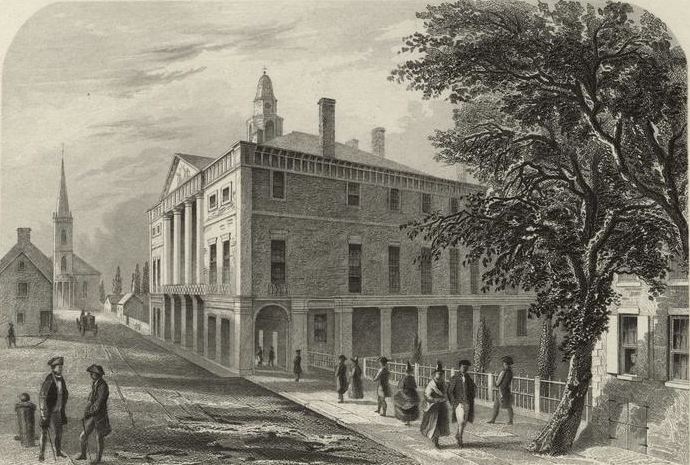Senate Majority: Pro-Administration | House Majority: Pro-Administration | |
 | ||
Members: 21–26 Senators59–65 Representatives0 Non-voting members | ||
The First United States Congress, consisting of the United States Senate and the United States House of Representatives, met from March 4, 1789, to March 4, 1791, during the first two years of George Washington's presidency, first at Federal Hall in New York City and later at Congress Hall in Philadelphia. With the initial meeting of the First Congress, the United States federal government officially began operations under the new (and current) frame of government established by the 1787 Constitution. The apportionment of seats in the House of Representatives was based on the provisions of Article I, Section 2, Clause 3 of the Constitution. Both chambers had a Pro-Administration majority. Twelve articles of amendment to the Constitution were passed by this Congress and sent to the states for ratification; the ten ratified as additions to the Constitution on December 15, 1791 are collectively known as the Bill of Rights.
Contents
Major events
Session 1
Held March 4, 1789, through September 29, 1789, at Federal Hall in New York City
Session 2
Held January 4, 1790, through August 12, 1790, at Federal Hall in New York City
Session 3
Held December 6, 1790, through March 3, 1791, at Congress Hall in Philadelphia
Constitutional amendments
States admitted and territories organized
Party summary
There were no political parties in this Congress. Members are informally grouped into factions of similar interest, based on an analysis of their voting record.
Details on changes are shown below in the "Changes in membership" section.
Senate
During this congress, two Senate seats were added for North Carolina and Rhode Island when each ratified the Constitution.
House of Representatives
During this congress, five House seats were added for North Carolina and one House seat was added for Rhode Island when they ratified the Constitution.
Senate
House of Representatives
Members
This list is arranged by chamber, then by state. Senators are listed in order of seniority, and Representatives are listed by district.
Senate
Senators were elected by the state legislatures every two years, with one-third beginning new six-year terms with each Congress. Preceding the names in the list below are Senate class numbers, which indicate the cycle of their election. In this Congress, all Senators were newly elected, and Class 1 meant their term ended with this Congress, requiring reelection in 1790; Class 2 meant their term ended with the next Congress, requiring reelection in 1792; and Class 3 meant their term lasted through the next two Congresses, requiring reelection in 1794.
Skip to House of Representatives, belowHouse of Representatives
The names of members of the House of Representatives are listed by their districts.
Changes in membership
There were no political parties in this Congress. Members are informally grouped into factions of similar interest, based on an analysis of their voting record.
New York, North Carolina, and Rhode Island, were the last states to ratify the U.S. Constitution, and because of their late ratification, were unable to send full representation at the beginning of this Congress. Five Senators and nine Representatives were subsequently seated from these states during the sessions as noted.
Senate
There was 1 resignation, 1 death, 1 replacement of a temporary appointee, and 6 new seats. The Anti-Administration Senators picked up a 1-seat net gain and the Pro-Administration Senators picked up 4 seats.
House of Representatives
There was 2 resignations, 1 death, and 6 new seats. Anti-Administration members picked up 3 seats and Pro-Administration members picked up 2 seats.
Committees
Lists of committees and their party leaders.
